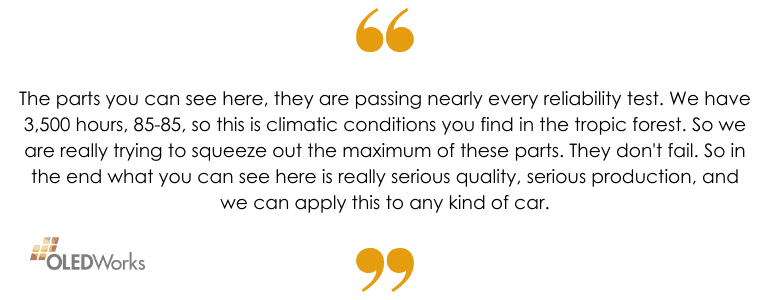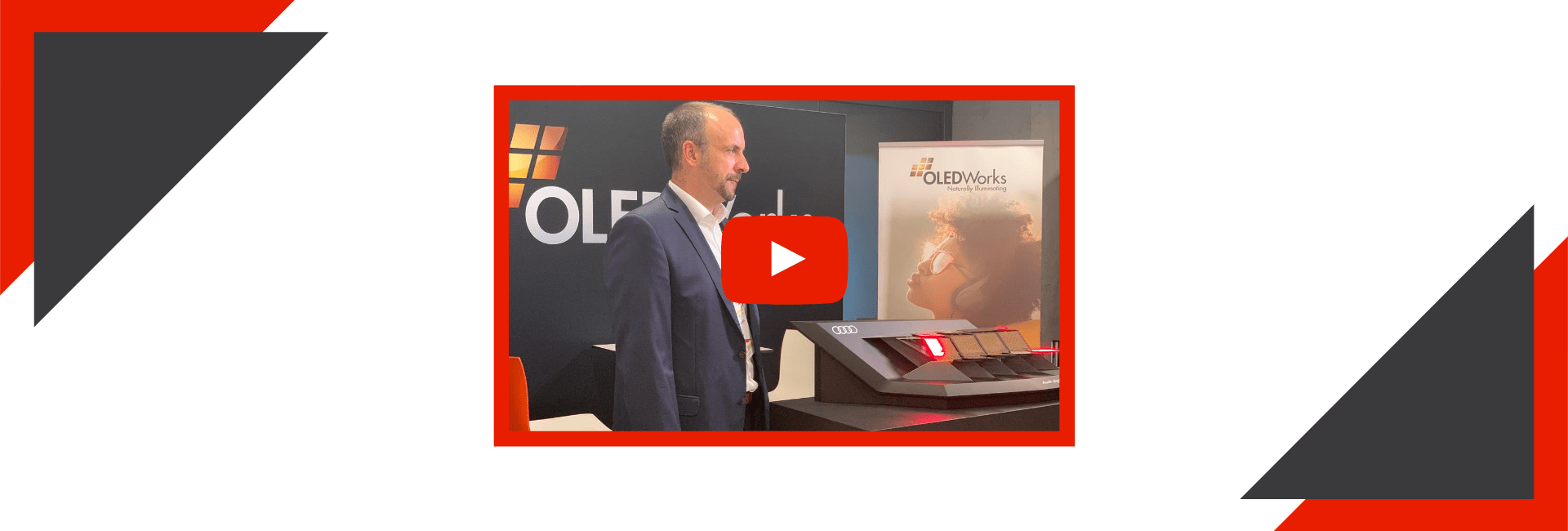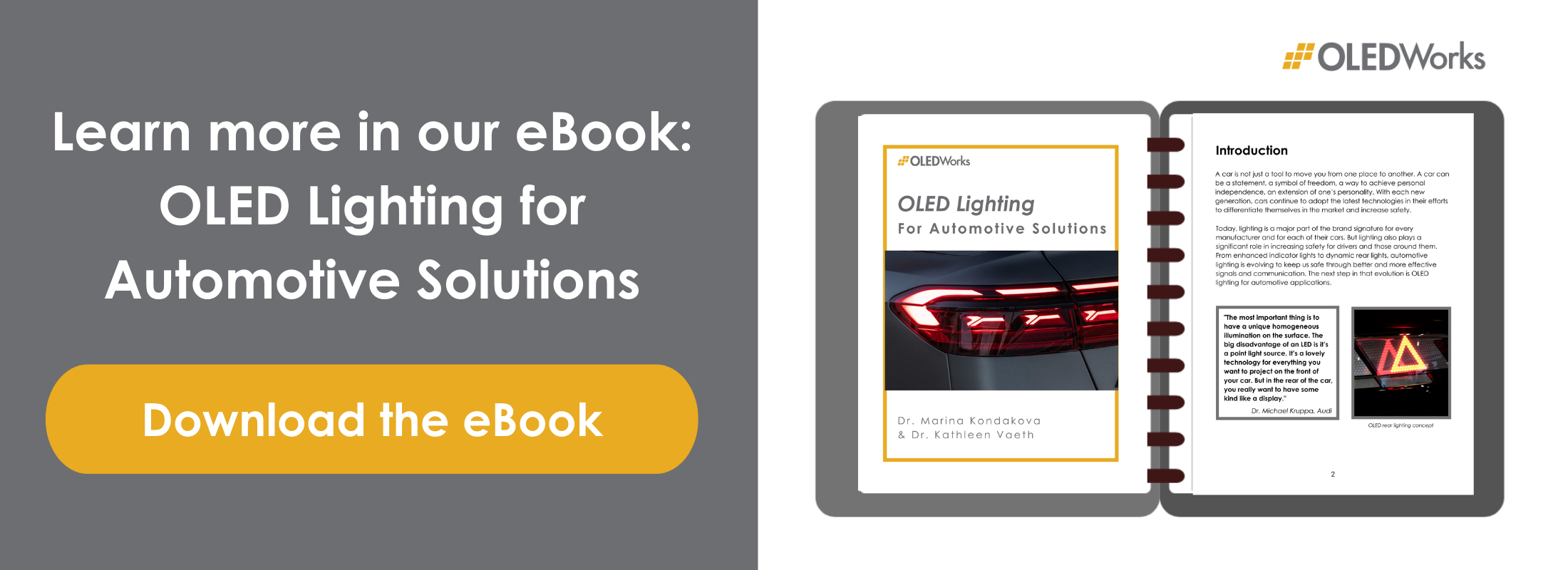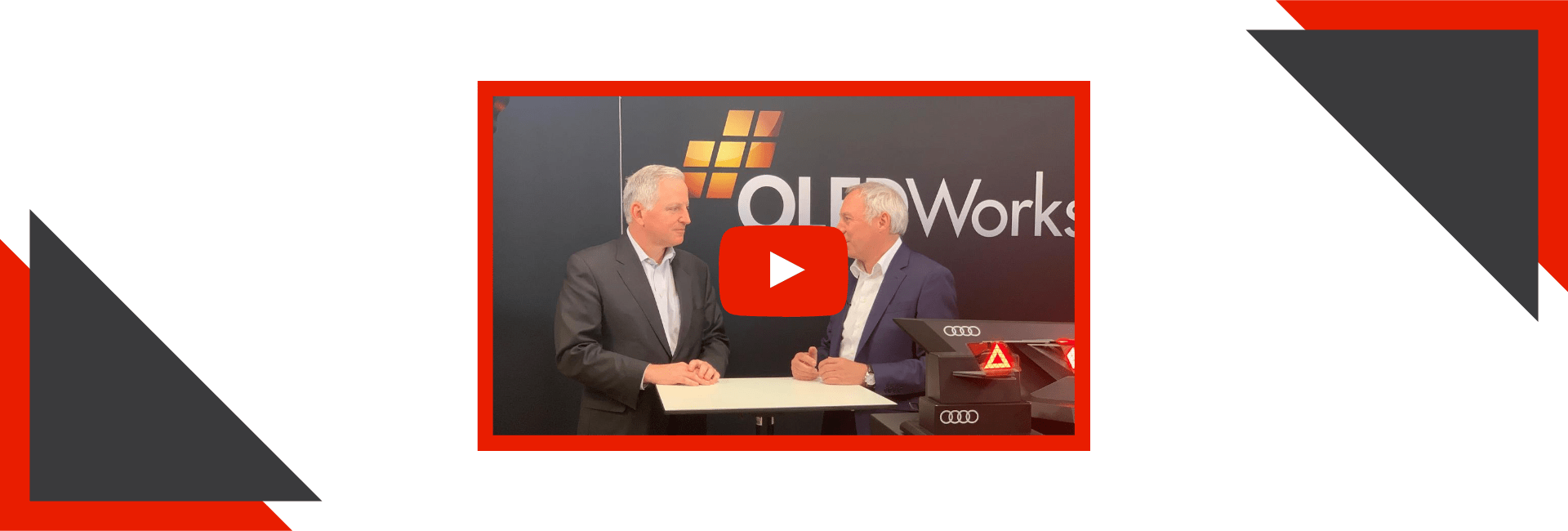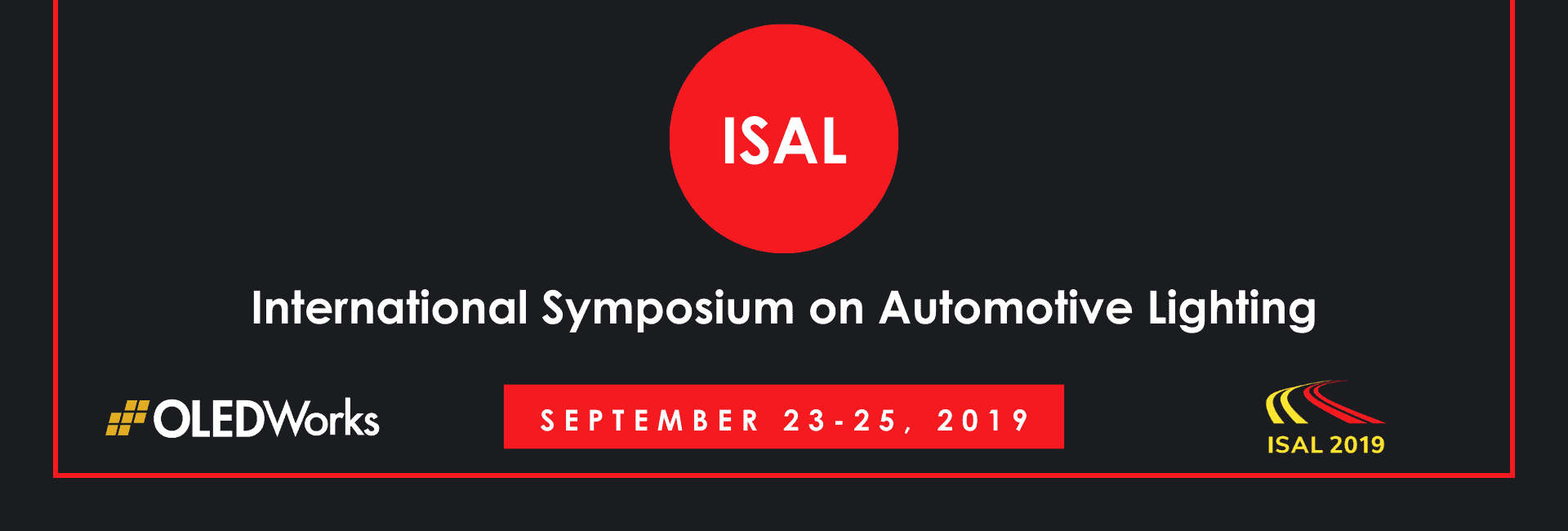![[eBook] OLED Lighting for Automotive Solutions](https://www.oledworks.com/wp-content/uploads/2022/02/Automotive-eBook-Header.png)
Audi’s Dr. Michael Kruppa, Head of Rear Lamp Development, was interviewed by OLEDWorks at ISAL 2019 on industry collaboration and the unique capabilities and commercial readiness of OLED light for automotive
Let’s start with a simple question. Why did you choose OLED?
Dr. Kruppa: So, we’re talking about rear combination lamps. So, the most important thing is to have a unique homogeneous illumination on the surface. The big disadvantage of an LED is it’s a point light source. It’s a lovely technology for everything you want to project on the front of your car. But in the rear of the car, you really want to have some kind, like a display. Therefore, a surface technology like the OLED is the best thing you can do. It’s flat, it’s white [ ] it is wonderfully homogeneous.
As you can see here [Dr. Kruppa points to the demonstration of their Digital OLED Technology] you have a wonderful chance to play with contrast ratios very close to each other. And therefore, all of our design ideas at Audi can be displayed on such a kind of OLED from OLEDWorks.
What are the advantages of an OLED compared to other technologies?
K: The simple thing is, it’s a surface light source. So in the end you don’t have to scatter the light which is being emitted from a point light source so you have a perfect intrinsic optical efficiency, which is way better than any LED solution.
The second thing is, you have a very small package, which means you don’t have to have a huge polymer frame like you see nowadays on the surface LEDs. You have a very sharp cutoff between dark and light areas, and this is what we are continuously working on in our new technologies. And this was also the origin and the terminus where the name “Digital OLED” was born.
Why is customizable lighting design so important for the Audi group?
K: So, in the end, all the customers from nowadays, new cars, they are used to wonderful LED lighting solutions. So, in the end you see a very nice BMW, Daimler, Ford, whatever it be. Audi was one of the first companies applying the LED solution in the car, and they want to have something new.
In the end, they want to have a chance to choose themselves how the car looks. So when you go to the configuration of your car, you’ll select the lacquer, you’ll select the color of the leather of your seats. And in the same way, our ideas now with digital OLED or digital lighting, by simple changes in software, you can give the car a new complete appearance at night. And this is what our customers are loving. Especially the Asians, they want to have something to play around. And in combination with what was invented in our pre-development from Stephan Berlitz and his team, all these dynamic effects. So meaning, coming home and leaving home scenarios can now be tailor-made for every customer.
And this is just bits and bites, you don’t have to build a complete new rear combination lamp, it’s just by simple software information you can change the night appearance of the car.
When can we expect digital OLED in production, and in which cars?
K: Of course, you have to understand I cannot disclose the complete strategy from Audi! Nevertheless, the wording of digital OLED was born already somehow in the A8. So in the end, we already have segments which are used for animation sequences. We are now continuously enriching this by new functionalities in the car. The first car will be on the market in 2020, and what you can see here with the Digital OLED 2.0 as we name it, you can expect in our wonderful cars by 2022. There will be other cars in 2021 and a lot of cars in 2022-23 which will utilize this technology in rear combination lamps.
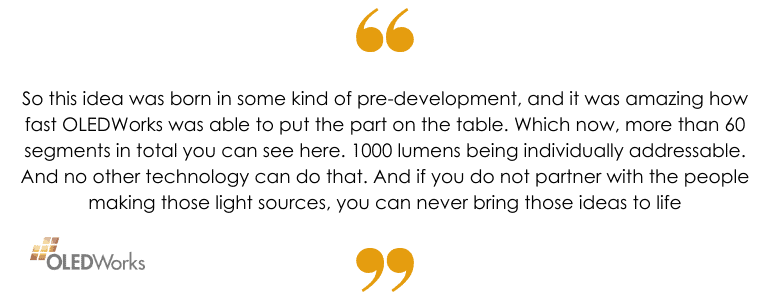
So this is a new technology. How important has it been to partner with your suppliers in order to accomplish these objectives?
K: So you can never invent or implement a new technology if you don’t have a decent supplier which is helping you to do that. So in the end we always partner with people which have ideas. The luminaire makers, the lamp makers, the light source makers. And in combination with approaches in our pre-development, we see what those technologies can do, and then we work together to work out what is the best thing.
I think especially for OLED, general lighting is suffering still from what we see in the way of let’s say, light scattering with polymers and plastic. The same was here when we were starting. BMW and Daimler, they started to use it as a simple surface light source. And everyone was asking “hey after the coming home/leaving home sequence, what to do next?” And what you can see here [points to the demonstration of Digital OLED Technology] I think it’s really amazing if you put new functionality inside this light source, you’re creating a new unique selling point.
So this idea was born in some kind of pre-development, and it was amazing how fast OLEDWorks was able to put the part on the table. Which now, more than 60 segments in total you can see here. 1000 lumens being individually addressable. And no other technology can do that. And if you do not partner with the people making those light sources, you can never bring those ideas to life.
What’s next in your mind for OLED for automotive?
K: So first of all, of course, cost down. We have to see how we can make it cheaper. We have a larger variety of cars on the street which are using that. Of course, we’re now playing around with the number of segments, we are playing around with the way geometric elements can be illuminated. We’re playing around with more content for car-to-X communication. So we’re starting with a triangle first, but we would like to implement even more dedicated information, so that the people really understand what is happening on the road. And of course we are dreaming of Digital OLED 3.0. There are some ideas, we cannot disclose all of them, but, in the end I think it will be next step after the parts you see here.
Can you tell us about commercial readiness of OLED technology and its viability for automotive?
K: Yes, absolutely. So this was one of the biggest challenges, and I think Stephan can also tell you a little bit more about how it came to the origin of the OLED. Everybody was asking the question, “it’s an organic LED. And organic materials in automotive exteriors are used to degrading.” So in the end, the team from Stephan, our OLED expert Dr. Thomas, put a lot of effort together with quality guys to prove this topic is ready for automotive exterior.
The parts you can see here, they are passing nearly every reliability test. We have 3,500 hours, 85-85, so this is climatic conditions you find in the tropic forest. So we are really trying to squeeze out the maximum of these parts. They don’t fail. So in the end what you can see here is really serious quality, serious production, and we can apply this to any kind of car.